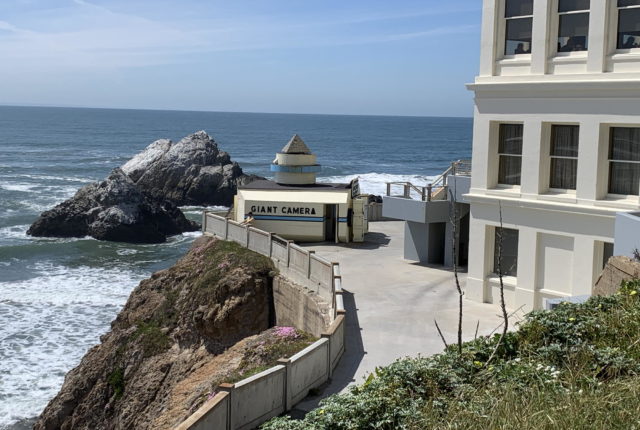Yesterday Debbi and I took the day off to go to San Francisco for the first time in several months. We went to California Academy of Sciences, and Borderlands Books, which are two of our usual haunts, but we also went somewhere I’ve never been before: To see the Camera Obscura. (See also the Wikipedia entry.)
I’m a big fan of the Lands End area, which is in the northwest corner of the city, west of the Golden Gate Bridge, at the northern reach of the Great Highway and Ocean Beach. The main parking lot is the home of the USS San Francisco Memorial and access to some great walking trails. The area is best known for the Cliff House and the ruins of the Sutro Baths, but decades ago it was known for Playland at the Beach, an amusement park which opened early in the 20th century, and which closed in 1972.
It seems two remnants of Playland survived its closure: One, the Musée Méchanique, moved to Fisherman’s Wharf on the other side of the city when the Cliff House was renovated starting in 2002. The other is the Camera Obscura, located in a small building accessible by a short trail to the left of the Cliff House, or by stairs to its right leading to a paved area behind the building. While I’d visited the Musée several times at its location here, I don’t remember the Camera at all, and feel like I only heard of it a year or so ago.
We parked in a nearby lot which had broken car glass in many spaces. My guess is that people park there at night to go walking and that’s when most of the break-ins occur. We didn’t see any cars with broken windows. There’s also street parking, as well as the lot for the Lands End Lookout building, above the Baths.
Admission was $3 for each of us, but it was well worth it for the novelty: The Camera had a 360° angle of view, and once the operator turns it on, it slowly rotates through its arc, projecting the image of the area around the building on a large concave wooden panel in the middle of the room. Viewers must slowly walk around the panel to stay oriented to the image, but it is amazingly sharp and clear. Which makes sense, since what we think of as a “camera” – film or digital – has a resolution of the image it produces, while this camera has effectively infinite resolution – or, at any event, probably higher resolution than the human eye can perceive.
It takes about six minutes to complete the circuit, so during the second cycle when the camera was pointed at the Cliff House, Debbi and I checked out the small but neat collection of holograms around the room.
The Camera Obscura is in some ways emblematic of San Francisco historical sites. Most of SF was destroyed in the 1906 earthquake, so most of the historical sites that remain have a sort of immediacy to them: Some of them, like the Camera, are still functioning. Others were functioning within the lifetimes of many people living (such as Alcatraz). In a way this is a testament to the pace of technological (and sometimes social) progress in the last century: The Camera Obscura is still pretty cool today, and it must have been pretty awesome when it opened in the late 1940s. Nonetheless, though that was only 70 years ago, it feels like a different era in history. But the Camera is not a relic, it’s a representative.

